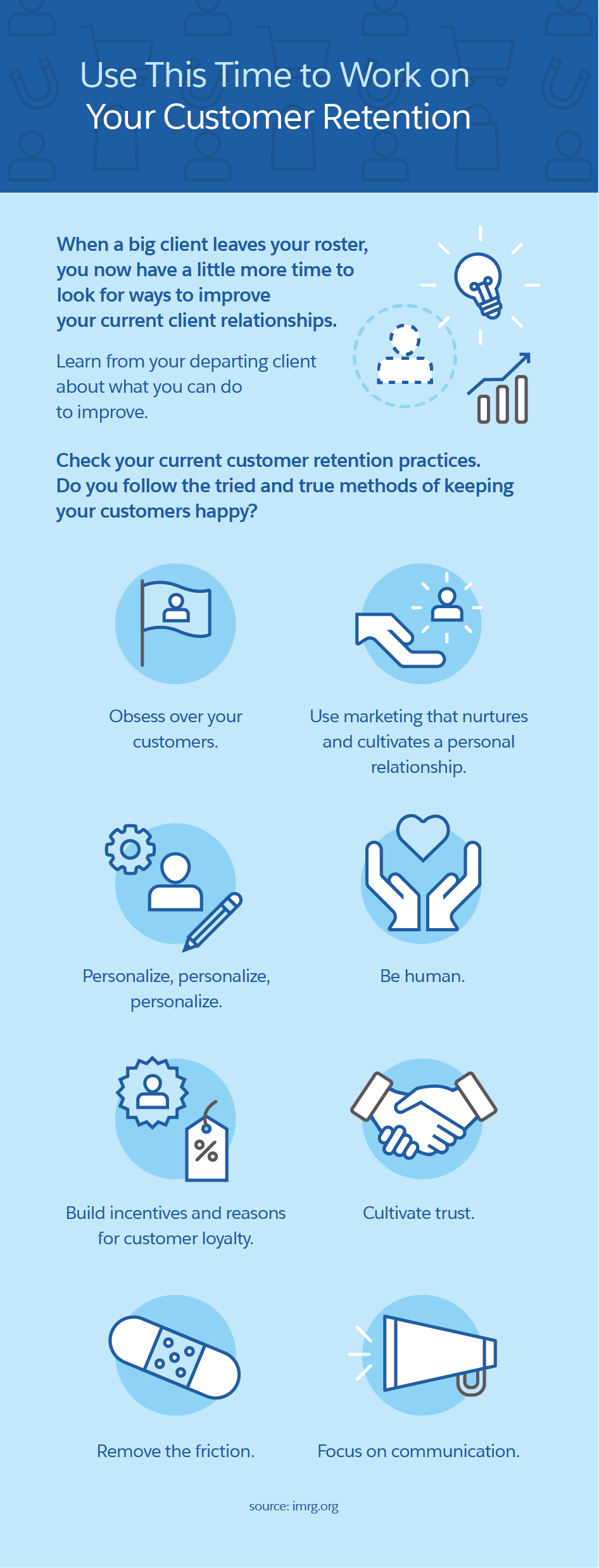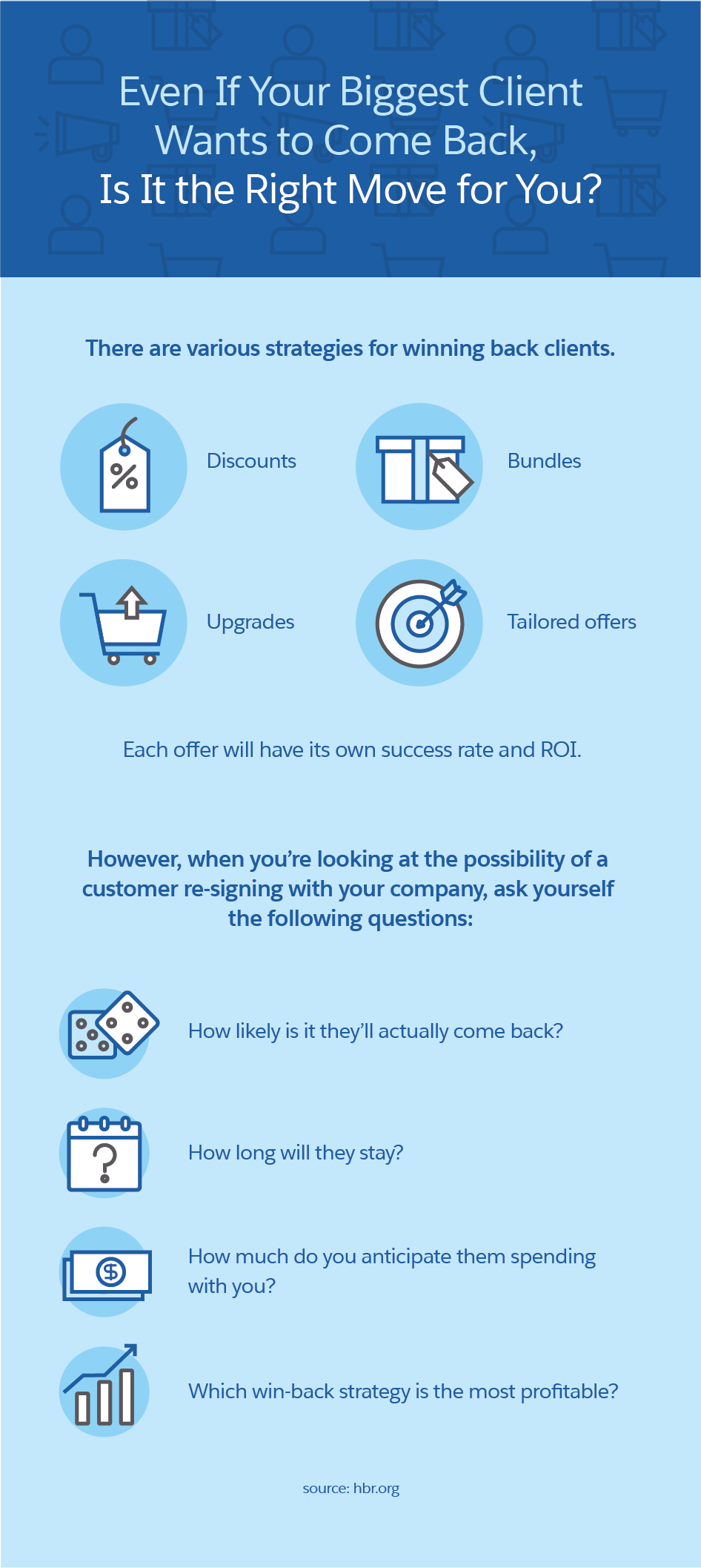You will lose a client during your career.
You may be reading this article because you searched the internet for how to deal with the situation you found yourself in just this morning. Or perhaps you’re still reeling from the phone call you received yesterday from your largest client.
However, you may be one of the lucky few reading this who hasn’t lost a client. Not yet, at least.
Because, mark my words, this cold, harsh truth will rear its ugly head at least one time, if not more, during your professional career.
Sometimes the client leaves due to no fault of your own. Other times it’s completely on your organization. Often it’s a combination of the two.
A pity party about the client’s decision won’t help you with your situation; retrospection and action will. Any salesperson who’s been in the game long enough has been in your shoes. It’s not fun. But losing your biggest customer doesn’t have to be the end of the road for your sales career or your organization.
Here are five necessary steps you can take to turn the loss of your biggest customer into an even bigger opportunity for your company’s future.
If You Think You’re Going to Lose a Big Client, Follow These Steps
- Deal with facts. Don’t let your imagination run wild.
- Open up your communication channels and have straightforward conversations with your client.
- Don’t get personal.
- Get busy chasing new business.
- Ask the difficult questions and learn from the experience.
- Always have a rainy day plan.
- Remember that prevention is better than finding a cure.

1. Thank the client
Even though you might feel like they just terminated your relationship, thank them for their business during the time you worked together. Let them know you appreciate them as a customer in a classy manner and use the opportunity to do two very important things most people neglect in the moment: continue the relationship and ask for feedback.
Leave the door open for future business deals. You don’t know what the future holds for either party and, speaking from experience, they may very well call you in a year or two when their new vendor isn’t meeting their expectations or when they realize you can better deliver what they need.
Ask for feedback. Are there areas in which your team can improve their service and offerings? What made the client see the need for a change? This is a great chance to learn why the client is changing providers, as well as create internal reviews about your company’s systems that may need to be improved.
This specific goodbye doesn’t have to be permanent; in fact, some business relationships reconnect after the new vendor/client relationship isn’t up to the standard the client believes they should receive. Use this opportunity to keep the door open while understanding that there are areas your organization will want to improve before potentially working together again.
2. Be honest with your team about the change
Don’t sugarcoat the news when you break it to your team. Let them know directly that the client is leaving, reasons why (if pertinent), and most importantly, what you plan to do about it now. Trying to soften the blow may only create confusion internally with your team. It’s important to tackle this problem head-on with your team.
Share your plan with confidence and explain that you believe the team will rebound and can use this as a learning experience to spring forward. Let them know that together you will use this time to improve your organization, lines of communication with all clients, and service offerings. Make sure your team believes, just like you do, that your company will rebound from this.
Teams look to their leaders for confidence and security during times of stress and discomfort. Give it to them, even if you’re still trying to figure out the new plan behind closed doors.
Use This Time to Work on Your Customer Retention
- When a big client leaves your roster, you now have a little more time to look for ways to improve your current client relationships.
- Learn from your departing client about what you can do to improve.
- Additionally, check your current customer retention practices. Do you follow the tried and true methods of keeping your customers happy?
- Obsess over your customers.
- Use marketing that nurtures and cultivates a personal relationship.
- Personalize, personalize, personalize.
- Be human.
- Build incentives and reasons for customer loyalty.
- Cultivate trust.
- Remove the friction.
- Focus on communication.

3. Look for ways to improve your current client relationships
It’s easier to grow your business with your current customers instead of spending excessively to try and acquire new ones — although prospecting is important, too. Take this opportunity to review your current roster of clients. Individually evaluate each one, specifically looking for areas your organization can improve communication, the overall relationship, and potential new areas of growth.
You can also review each client’s current business with your company to see if there is an opportunity to grow the relationship with additional offerings and upsells. These transactions are especially beneficial because they would be within your already-established working relationship.
4. Reinvest your newly available bandwidth into prospecting
What better way to spend your unexpectedly available time than to invest it in new business development? Use the hours you previously committed to the former customer toward researching, prospecting, and calling potential new clients.
The one immediate upside to losing a client is the bandwidth you and your team get back — bandwidth that can be wasted complaining or utilized looking for new customers to fill the calendar back up.
It can be easy to let new business development slow down and take a backseat when business is thriving. We forget about the importance of prospecting for new customers when cash flow is coming in strong, but we’re quickly reminded of their importance the moment we lose a large portion of that income.
You can spend your newly acquired free time scrambling, or you can invest it back into your company by using it to acquire more revenue and customers.
5. Setbacks set up even bigger wins — with the right mindset
No one likes a setback. We feel hurt and disappointed by the relationship we feel we’ve lost, especially when it’s our biggest client. However, there are lessons in each professional breakup that can pivot our teams toward brighter tomorrows.
But our setbacks only set up future winning opportunities if we look at the situation as a learning experience instead of a dead end. Take this quote from Walt Disney: “All the adversity I’ve had in my life, all my troubles and obstacles, have strengthened me . . . You may not realize it when it happens, but a kick in the teeth may be the best thing in the world for you.”
Even If Your Biggest Client Wants to Come Back, Is It the Right Move for You?
- There are various strategies for winning back clients, including:
- Discounts
- Upgrades
- Bundles
- Tailored offers
- Each offer will have its own success rate and ROI.
- However, when you’re looking at the possibility of a customer re-signing with your company, ask yourself the following questions:
- How likely is it they’ll actually come back?
- How long will they stay?
- How much do you anticipate them spending with you?
- Which win-back strategy is the most profitable?

Carol Dweck’s research on the growth mindset dives into how successful performers view negative situations as opportunities for growth and learning. Individuals with this growth mindset believe they can develop new skills, are open to feedback, and constantly look to challenging situations — such as losing your biggest source of income — as opportunities to grow and get better.
There are great lessons in every business relationship. By taking an honest evaluation of the working process, we can find room for improvement in how we:
Onboarded a client
Communicated with the client
Managed the client’s projects
We may even learn during the process that despite the revenue stream, the client we lost wasn’t the best fit for our organization and services — and that we need to have stronger guidelines for clients we sign. The only way to find these lessons is to take our emotions out of the situation and intentionally look for them.
Script a great ending
I was devastated the first time I lost a client for my consulting practice. They were my largest income source and the brand on my client roster that I used when pitching new clients. The loss, however, forced me to review how well I was managing our relationship.
After speaking with the client and thoroughly reviewing my processes, I saw holes that needed to be fixed. I immediately revamped my entire onboarding and ongoing client-relationship programs. The change not only strengthened my roster of smaller clients, but when that big client called me again two years later, our working relationship was vastly improved because of what I’d learned after our previous breakup.
Not all professional stories end with you and your ex-client getting back together like two stars in a romantic comedy. But if you use the negative situation to improve your company, grow your business, and implement the lessons with your team, you can write a better ending for your organization.
Share "How to Turn the Loss of a Big Customer into a Bigger Opportunity" On Your Site



